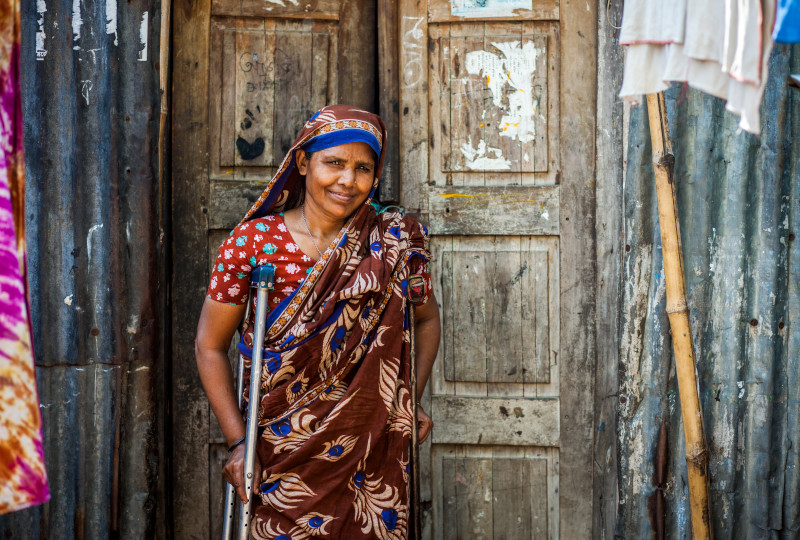Re-thinking disability inclusion for the SDGs
June 19, 2023

Persons with disabilities have been disproportionately affected by the events of recent years, including the COVID-19 pandemic.
This year marks halfway towards the Sustainable Development Goals (SDGs), an ambitious agenda which set out to transform our world. We have always known that the goals cannot be realized without the inclusion of persons with disabilities. From poverty to inequality, climate to health the promise to leave no-one behind is the bedrock of the SDG call to action.
Unfortunately, the midway indicators should give us all cause for concern. The UN Secretary-General recently announced that progress on 50 percent is weak and insufficient and we have stalled or gone into reverse on more than 30 percent of the goals.
And what can this lack of SDG progress tell us about disability inclusion? Worryingly, very little. While the SDGs include persons with disabilities, this does not fully extend into the monitoring. Only seven out of 169 targets specifically address disability inclusion and only 10 of their 231 indicators explicitly require disability data disaggregation.
However even without specific SDG data, the extent of progress must be called into question when we see that, in 2023, the 1.3 billion people worldwide who experience significant disability, still face a range of barriers to inclusion.
While specific actions to progress disability inclusion undoubtedly need reinvigorating, it is also important to remember that we are living in unprecedented, testing times. The COVID-19 pandemic, the largest cost of living crisis this generation has ever seen, climate change and increasing conflicts are placing pressure on communities all over the world at a ferocity and speed which we have rarely seen before. And while everyone may be affected by these interconnected crises, they are not affected equally. The most vulnerable always bear the greatest burden and persons with disabilities have been disproportionately affected by the events of recent years.
Yet despite these challenges, across the world, disability inclusion has been gathering greater momentum. Even in the most challenging of crisis settings, such as the war in Ukraine, we have seen that early assessments such as the one UNDP carried out – looking at how to improve the accessibility of information and notifications in crises, and the specific difficulties persons with disabilities face during evacuations – have brought together persons with disabilities, civil society and government partners to help bring about change. These joint efforts also give recognition to the importance of not only taking into account the needs of persons with disabilities as beneficiaries of aid, but also their engagement as key actors in humanitarian response planning.
An increased understanding of intersectionality and recognition of the multiple factors which affect people’s lived experience is also taking hold, and it is awe-inspiring to see the extent to which organizations of persons with disabilities are driving forward this change.
But it is time for global and country level policy commitments to catch up. At a global level monitoring of the SDGs must include greater involvement of organizations of persons with disabilities, and this should be matched with investment for these groups, to ensure capacity building programmes around the SDGs can scale up. Without this, the disability community and underrepresented groups will continue to struggle to take part in national SDG plans.
The collection of disability-specific SDG data is also a priority. Persons with disabilities are often excluded from participating in data collection processes, leading to an under-representation of their perspectives. Data collection mechanisms designed by and with persons with disabilities and their respective organizations, including disaggregated data on disability types, age and gender, are vital yet currently missing.
At a national level, we must fast track implementation of the UN Convention on the Rights of Persons with Disabilities, which sets out to promote, protect and ensure the human rights of persons with disabilities. Significant progress has been made since 2008, when the convention came into force, but more must be done to develop policies and legislative frameworks in close consultation with persons with disabilities and their respective organizations, and to couple this with strong political will and the necessary resources. UNDP and the International Disability Alliance (IDA) are working together with global partners to advance this work, recognizing that it is a prerequisite to achieving the SDGs.
But much more remains to be done. Because we cannot truly claim progress when in large parts of the world, persons with disabilities are still unable to equally and meaningfully participate in the world around them. When they remain unheard and unseen in programmes designed to meet their needs, and when systemic barriers to their full inclusion and participation in society still exist.
This year offers an important moment for reflection, to take stock of what has been achieved but also - critically - to course correct. Persons with disabilities are some of the most marginalized and excluded in the world. Righting this wrong is one of the ways that we can get the SDGs and the 2030 Agenda back on track. This is not a task for one group or one country. It will require cooperation across the board, political will and perhaps most importantly – real collaboration with persons with disabilities and their representative organizations – recognizing that they are the ones who stand to benefit or lose the most from the progress being made.

 Locations
Locations
